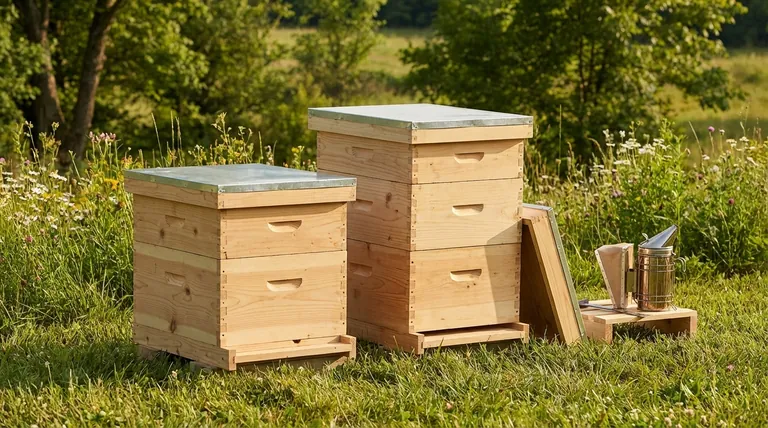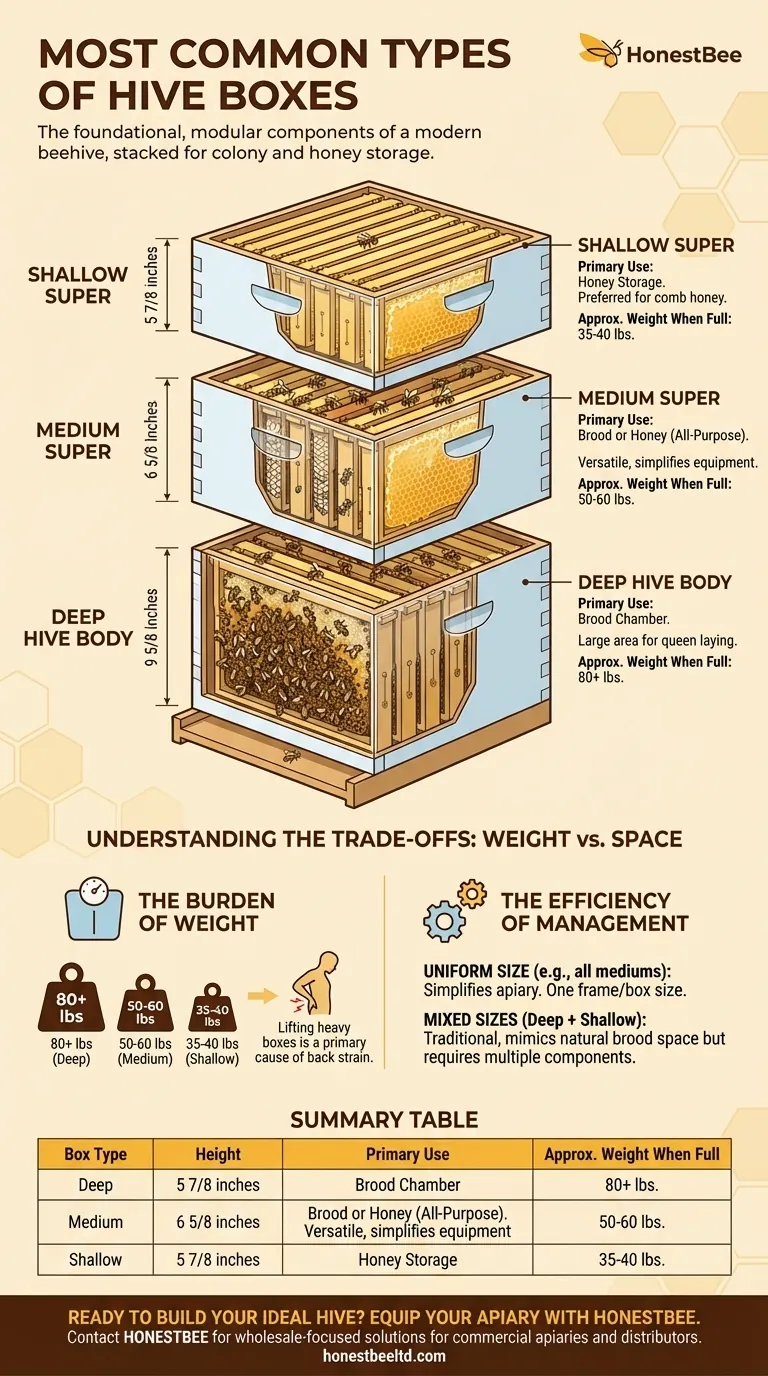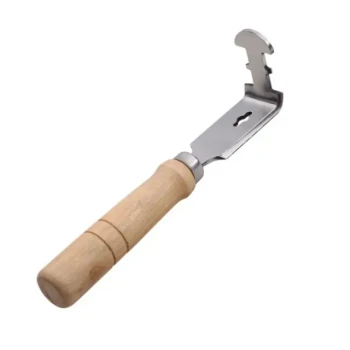The foundational components of any modern beehive are its boxes. These modular containers, also called "supers" or "bodies," are stacked to house the colony and store honey. The three standard types of hive boxes are the deep hive body, the medium super, and the shallow super, each differing in height and designed for a specific function within the hive.
Choosing your hive box configuration is a fundamental decision that balances the bees' need for space against your own goals for honey production and physical limitations. The size of the box directly impacts its weight when full and how you manage your colony throughout the season.

The Anatomy of a Hive Box System
A modern Langstroth hive is a vertical stack of boxes. The bottom boxes are dedicated to the brood chamber, where the queen lays eggs and raises young bees. The boxes added on top, called "supers," are intended for honey storage.
All standard Langstroth hive boxes share the same length and width to ensure they are stackable. The only dimension that changes is the height, which determines the box's purpose and its weight when full of honey and comb.
The Three Standard Box Sizes
Understanding the role of each box size is crucial for effective hive management. Most beekeeping suppliers offer equipment in these three standard sizes.
The Deep Hive Body (Brood Box)
The deep box is the largest of the three, typically measuring 9 5/8 inches in height.
Its primary purpose is to serve as the brood chamber. This gives the queen a large, uninterrupted area to lay eggs, which mimics the colony's natural tendency to build a large, unified nest. A typical hive setup uses one or two deep boxes for the brood nest.
The Medium Super (The "All-Purpose" Box)
The medium super is the versatile middle-ground, measuring 6 5/8 inches in height.
It can be used for honey storage above the brood chamber or, increasingly, as a brood box itself. Many beekeepers prefer to use all medium boxes for the entire hive to simplify equipment and reduce a single box's maximum weight.
The Shallow Super (The Honey Box)
The shallow super is the smallest, measuring 5 7/8 inches in height (or sometimes 5 11/16 inches).
Its role is almost exclusively for honey storage. Because it's the lightest of the three when full, it is much easier to lift and handle during honey harvesting. It is also the preferred size for producing section comb honey.
Understanding the Trade-offs: Weight vs. Space
Your choice of box size is not just about the bees; it's about your ability to manage the hive safely and effectively. The primary trade-off is between the weight of a full box and the efficiency of managing the hive's space.
The Burden of Weight
The weight of a full box is a serious consideration, especially for beekeepers with physical limitations.
- A full deep box can weigh 80 pounds or more.
- A full medium super weighs around 50-60 pounds.
- A full shallow super weighs around 35-40 pounds.
Lifting heavy boxes is a primary cause of back strain among beekeepers. Overlooking this factor can make the hobby physically unsustainable.
The Efficiency of Management
Using different box sizes creates different management workflows.
Using a single, uniform box size (typically all mediums) simplifies your apiary. You only need to purchase and store one size of box and one size of frame, making equipment swaps and storage much easier.
Conversely, a traditional setup with deep brood boxes and shallower honey supers requires managing multiple component sizes but may align more closely with the colony's natural brood-rearing instincts.
Making the Right Choice for Your Apiary
Ultimately, there is no single "correct" configuration. The best setup depends entirely on your physical abilities and beekeeping goals.
- If your primary focus is a traditional setup and maximizing brood space: Use one or two deep boxes for the brood chamber and medium or shallow boxes for honey supers.
- If your primary focus is minimizing heavy lifting and simplifying equipment: Run your entire hive using all medium boxes for both brood and honey.
- If your primary focus is producing comb honey or having the lightest possible weight: Use shallow supers exclusively for your honey collection above the brood chamber.
Understanding these components empowers you to build a hive that works for both you and your bees.
Summary Table:
| Box Type | Height | Primary Use | Approx. Weight When Full |
|---|---|---|---|
| Deep Hive Body | 9 5/8 inches | Brood Chamber | 80+ lbs |
| Medium Super | 6 5/8 inches | Brood or Honey (All-Purpose) | 50-60 lbs |
| Shallow Super | 5 7/8 inches | Honey Storage | 35-40 lbs |
Ready to Build Your Ideal Hive?
Equip your apiary with the right boxes from the start. HONESTBEE supplies durable, high-quality beekeeping supplies and equipment in all standard sizes to commercial apiaries and distributors.
We understand that the right equipment is crucial for hive health and beekeeper safety. Let us help you simplify your operations with our wholesale-focused solutions.
Contact HONESTBEE today to discuss your equipment needs and request a quote!
Visual Guide

Related Products
- Australian Langstroth Beehive Boxes for Beekeeping Wholesales
- Langstroth Honey Bee Box Hive Boxes for Different Depths
- Portable Bee Mating Hive Boxes Mini Mating Nucs 8 Frames for Queen Rearing
- Wholesales Dadant Size Wooden Bee Hives for Beekeeping
- Professional Stainless Steel J-Hook Hive Tool
People Also Ask
- Why might a beginner be advised to start with a Langstroth hive? Unlock a Supportive Beekeeping Ecosystem
- How many frames fit into a standard beehive box? Choose Between 8-Frame and 10-Frame Hives
- What are the three types of beehives? Find the Perfect Hive for Your Beekeeping Philosophy
- What are the sizes of supers available in a standard hive? A Guide to Deep, Medium, and Shallow Boxes
- What other types of hives are available besides the Flow Hive? Explore Langstroth, Top Bar, and Warre



















